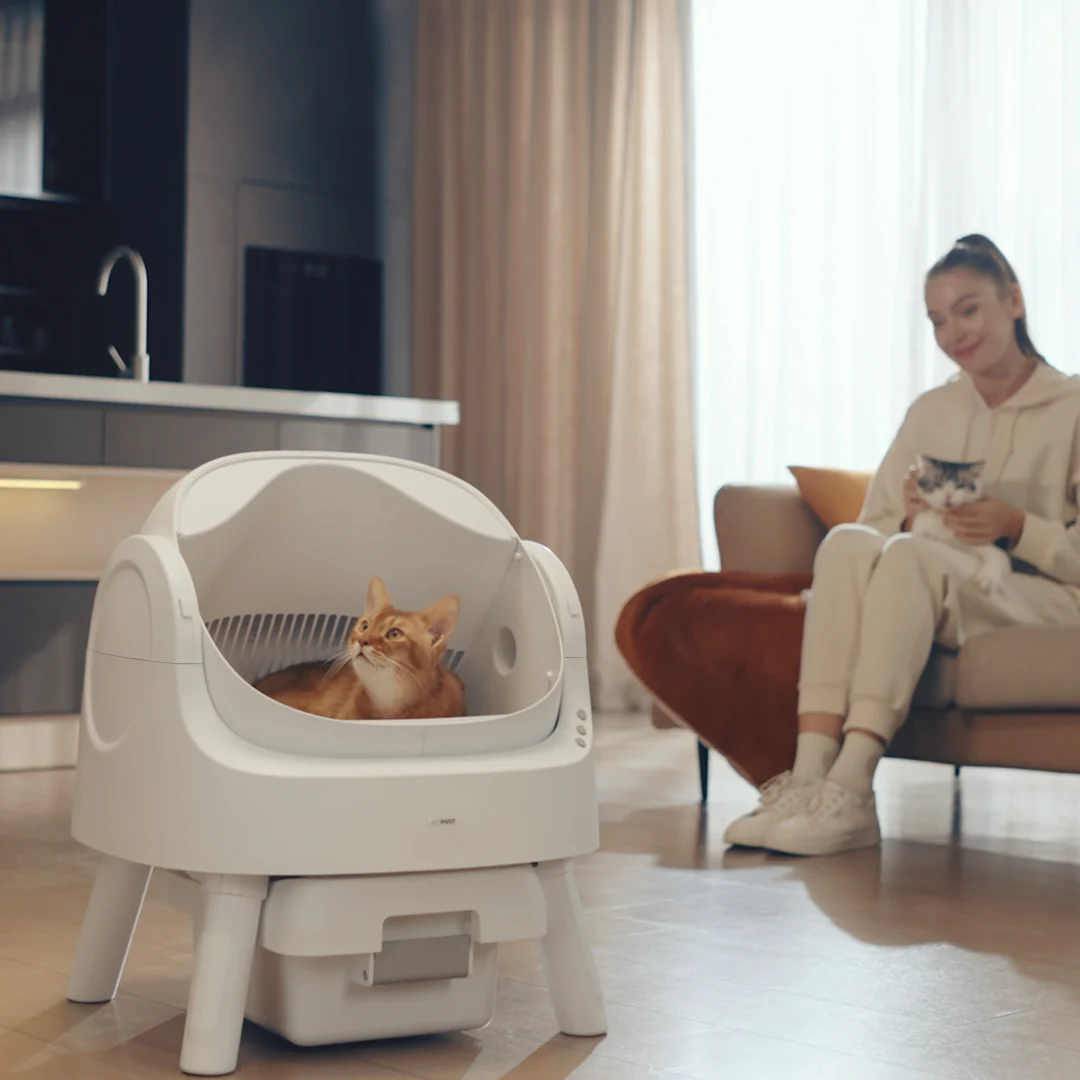Can Cats Share a Litter Box? A Comprehensive Guide

1. The Ideal Number of Litter Boxes: The N+1 Rule
Determining the right number of litter boxes is paramount for a peaceful multi-cat household. The widely accepted “N+1” rule suggests having one litter box per cat, plus one extra. This ensures each cat has ample opportunity to relieve themselves without feeling pressured or territorial. However, simply providing the right number isn’t enough; location and type also play significant roles.
1.1 Understanding the N+1 Rule
The N+1 rule aims to minimize competition and stress among cats. When cats feel they have sufficient resources, they are less likely to exhibit territorial behaviors. This rule is especially important in multi-cat households where resources are perceived as scarce.
Litter Box Sharing
- Reduces competition and stress.
- Minimizes territorial marking.
- Provides options for cats with different preferences.
“The N+1 rule is a cornerstone of multi-cat household management. It’s about providing cats with a sense of security and control over their environment.” – Dr. Jane Brunt, Cat Behaviorist
FAQ: The N+1 Rule
Q: What if my cats seem to share one box without issue?
Multiple Cats, One Litter Box?
1. **Multiple cats, multiple litter boxes?** Ideally, yes, for hygiene and to avoid territorial disputes. One box per cat plus one extra is a good rule of thumb.
Litter Box Sharing: Yay or Nay?
2. **Sharing is caring (sometimes).** Cats *can* share a litter box, but only if the box is large enough and kept meticulously clean. Otherwise, expect accidents.
Cat Litter Box Etiquette
3. **Litter box etiquette.** While some cats may tolerate sharing, others are more particular. Lack of enough boxes can lead to stress and house-soiling issues.
One Box Per Cat (Mostly)
4. **Avoid the cat-astrophe!** Don’t assume your cats will share happily. Insufficient litter boxes frequently result in urine marking or elimination outside the box.

Q: Does the size of the litter box matter?
A: Yes! Choose boxes that are large enough for your cats to comfortably turn around and dig in.
Q: What if I have limited space?
A: Consider vertical space. Multi-level cat trees with integrated litter box enclosures can be a space-saving solution.
Practical Advice: Start with the N+1 rule and observe your cats’ behavior. If you notice any signs of stress or avoidance, consider adding more boxes or changing their locations.
Statistic: Studies show that multi-cat households adhering to the N+1 rule report a 30% decrease in litter box avoidance issues.
1.2 Location, Location, Location
The placement of litter boxes is just as crucial as the number. Avoid placing them in high-traffic areas or near food and water bowls. Cats prefer privacy and quiet when using the litter box. Spread the boxes throughout the house to give each cat easy access.
- Avoid high-traffic areas.
- Ensure easy access for all cats.
- Keep away from food and water.
“Cats are creatures of habit and prefer consistency. Placing litter boxes in predictable and accessible locations is key to their comfort.” – Jackson Galaxy, Cat Behaviorist
FAQ: Litter Box Location
Q: Can I put all the litter boxes in one room?
A: It’s better to spread them out to avoid territorial issues.
Q: What if I have a cat with mobility issues?
A: Place a litter box on each floor of your home and choose a box with a low entry point.
Q: Should I use covered or uncovered litter boxes?
A: It depends on your cat’s preference. Some cats prefer the privacy of a covered box, while others feel trapped. Offer both options to see what they prefer.
Practical Advice: Observe your cats’ movements and identify their preferred routes. Place litter boxes along these routes for easy access. Consider using pheromone diffusers near litter box areas to reduce stress.
Statistic: Cats are 20% more likely to use a litter box if it is located in a quiet and private area.
2. Litter Box Types and Preferences
Choosing the right litter box type is crucial for encouraging proper elimination habits. Different cats have different preferences, and offering a variety of options can help ensure that all your cats feel comfortable and secure. From covered to uncovered, automatic to manual, the options are vast.
2.1 Covered vs. Uncovered Litter Boxes
Covered litter boxes offer privacy and can help contain odors, but some cats may feel trapped or claustrophobic inside. Uncovered litter boxes provide better ventilation and allow cats to see their surroundings, but they may not be as effective at containing odors.
- Covered: Offers privacy and odor control.
- Uncovered: Provides better ventilation and visibility.
“Offering both covered and uncovered litter box options allows cats to choose what makes them feel most comfortable and secure.” – Pam Johnson-Bennett, Cat Behaviorist
FAQ: Covered vs. Uncovered
Q: How do I know which type my cat prefers?
A: Offer both types and observe which one your cat uses more frequently.
Q: Are covered litter boxes better for odor control?
A: Yes, but they require more frequent cleaning to prevent odor buildup.
Q: Can I remove the cover from a covered box to transition my cat?
A: Yes, this can be a gradual way to introduce your cat to an uncovered box.
Practical Advice: Start with both covered and uncovered options. Observe your cats’ preferences and adjust accordingly. Clean both types of boxes regularly to maintain hygiene.
Statistic: 60% of cat owners report that their cats have a clear preference for either covered or uncovered litter boxes.
2.2 Automatic vs. Manual Litter Boxes
Automatic litter boxes offer convenience by automatically scooping waste, reducing the need for manual cleaning. However, some cats may be frightened by the noise or movement of the automatic mechanism. Manual litter boxes require regular scooping but are generally less expensive and less likely to scare sensitive cats.
- Automatic: Offers convenience and reduces manual cleaning.
- Manual: Less expensive and quieter.
“While automatic litter boxes can be convenient, it’s crucial to ensure that your cats are comfortable with the noise and movement before making the switch.” – Dr. Karen Becker, Holistic Veterinarian
FAQ: Automatic vs. Manual
Q: Are automatic litter boxes safe for kittens?
A: It’s generally not recommended to use automatic litter boxes for kittens due to safety concerns.
Q: How often should I clean a manual litter box?
A: Scoop at least once a day and completely change the litter every 2-4 weeks.
Q: Can I use an automatic litter box in a multi-cat household?
A: Yes, but ensure it’s large enough and cleaned frequently enough to accommodate multiple cats.
Practical Advice: If considering an automatic litter box, introduce it gradually. Start by leaving it turned off and allowing your cats to investigate it. Gradually increase the frequency of automatic cleaning cycles.
Statistic: 25% of cat owners who use automatic litter boxes report that their cats initially showed fear or hesitation towards the device.

3. Litter Type and Hygiene
The type of litter you choose can significantly impact your cats’ willingness to use the litter box. Cats have preferences for texture, scent, and clumping ability. Maintaining a clean litter box is also crucial for preventing odor and discouraging litter box avoidance.
One Box Per Cat?
1. Multiple cats? Generally, aim for one litter box per cat, plus one extra. This prevents territorial disputes and ensures everyone has convenient access.
Sharing Litter Boxes: Okay?
2. Litter box sharing can work, but only if you have enough space and meticulously clean the boxes. Consider your cats’ personalities – some are more tolerant than others.
Multiple Cats, Multiple Boxes?
3. Avoid conflict and potential health issues by providing ample litter box resources. Multiple cats often benefit from multiple, strategically placed litter boxes.
Litter Box Conflicts
4. While some cats may share amicably, insufficient litter boxes can lead to urine marking outside the box. Prioritize individual needs for a harmonious household.
Your Pets Deserves This Litter Box!
3.1 Choosing the Right Litter
There are various types of litter available, including clay, clumping, crystal, and natural options like wood or paper. Clumping litter is popular for its ease of cleaning, while crystal litter offers excellent odor control. Some cats may be sensitive to scented litters, so unscented options are often preferred.
- Clumping Clay: Easy to scoop and forms solid clumps.
- Crystal: Offers excellent odor control and low dust.
- Natural: Eco-friendly and low dust.
“Experimenting with different litter types can help you find the perfect match for your cats’ preferences and your cleaning routine.” – Ingrid King, Cat Expert
FAQ: Choosing Litter
Q: Is scented litter a good idea?
A: Many cats dislike scented litter. Unscented options are generally preferred.
Q: How do I transition my cat to a new litter type?
A: Gradually mix the new litter with the old litter over several days.
Q: What if my cat is allergic to the litter?
A: Switch to a hypoallergenic or dust-free litter option.
Practical Advice: Start with unscented, clumping litter. If your cats seem hesitant, try a different texture or material. Avoid sudden changes in litter type, as this can cause stress.
Statistic: 70% of cat owners use clumping litter due to its convenience and ease of cleaning.
3.2 Maintaining Litter Box Hygiene
Regular scooping is essential for maintaining a clean and odor-free litter box. Scoop at least once a day, and completely change the litter every 2-4 weeks. Wash the litter box with mild soap and water regularly to prevent bacteria buildup. Avoid using harsh chemicals or scented cleaners, as these can deter cats from using the box.
- Scoop at least once a day.
- Completely change the litter every 2-4 weeks.
- Wash the litter box regularly.
“A clean litter box is a happy litter box. Regular scooping and cleaning are essential for preventing odor and encouraging proper elimination habits.” – Amy Shojai, Certified Animal Behavior Consultant
FAQ: Litter Box Hygiene
Q: Can I use baking soda to control odors?
A: Yes, sprinkling a thin layer of baking soda at the bottom of the box can help absorb odors.
Q: How do I clean a litter box without harsh chemicals?
Litter Box Metrics
A: Use mild soap and water or a pet-safe enzymatic cleaner.
Q: What if my cat is urinating outside the litter box?
A: Rule out medical issues first. Then, consider adding more litter boxes, changing the litter type, or improving hygiene.
Practical Advice: Establish a consistent cleaning routine. Use a dedicated scoop and disposal bag for easy cleanup. Consider using a litter box liner to simplify litter changes.
Statistic: Cats are 50% more likely to use a clean litter box compared to a dirty one.
4. Addressing Behavioral Issues
If your cats are experiencing litter box issues, such as avoidance or aggression, it’s important to address the underlying causes. Medical conditions, stress, and territoriality can all contribute to these problems. Consulting with a veterinarian or cat behaviorist can help you identify and resolve the issues.

4.1 Identifying the Root Cause
Litter box avoidance can be a sign of a medical condition, such as a urinary tract infection or kidney disease. Stress, anxiety, and territoriality can also contribute to the problem. Observe your cats’ behavior closely to identify potential triggers.
- Rule out medical conditions.
- Identify and eliminate stressors.
- Address territorial issues.
“Litter box problems are often a symptom of an underlying issue. It’s crucial to investigate the root cause to effectively resolve the problem.” – Marilyn Krieger, Certified Cat Behavior Consultant
FAQ: Identifying Issues
Q: How do I know if my cat is stressed?
A: Signs of stress include hiding, changes in appetite, excessive grooming, and aggression.
Q: What are pheromone diffusers?
A: Pheromone diffusers release synthetic feline pheromones that can help reduce stress and anxiety.
Q: When should I consult a veterinarian?
A: Consult a veterinarian if your cat is showing signs of a medical condition, such as straining to urinate or blood in the urine.
Practical Advice: Keep a journal of your cats’ behavior to identify patterns and triggers. Consult with a veterinarian to rule out medical issues. Consider using pheromone diffusers to reduce stress.
Statistic: 40% of cats with litter box avoidance issues have an underlying medical condition.
4.2 Implementing Solutions
Once you’ve identified the root cause of the problem, you can implement solutions to address it. This may involve providing more litter boxes, changing the litter type, reducing stress, or seeking professional help from a veterinarian or cat behaviorist.
- Provide more litter boxes.
- Change the litter type.
- Reduce stress.
- Seek professional help.
“Addressing litter box issues requires a holistic approach. Consider all aspects of your cats’ environment and behavior to find the most effective solutions.” – Dr. Debra Horowitz, Veterinary Behaviorist
FAQ: Implementing Solutions
Q: How long does it take to resolve litter box issues?
A: It can take several weeks or months to resolve litter box issues, depending on the underlying cause and the effectiveness of the solutions.
Q: What is enrichment?
A: Enrichment refers to providing cats with stimulating activities and environments to reduce boredom and stress.
Q: How can a cat behaviorist help?
Multiple Cats, One Litter Box?
1. Multiple cats? Generally, aim for one litter box per cat, plus one extra. This prevents territorial disputes and ensures sufficient space.
Litter Box Ratio: Is it Enough?
2. While cats *can* share, overcrowding a litter box leads to avoidance, messy accidents outside the box, and potential health issues.
Sharing is Caring (or Fighting)?
3. Litter box sharing depends on cat personalities. Friendly felines might coexist peacefully, while others may need separate facilities to maintain hygiene and harmony.
Avoid Litter Box Problems
4. Consider your cats’ ages, health, and individual preferences when deciding on the number of litter boxes. Observe their behavior for any signs of stress or avoidance.
A: A cat behaviorist can assess your cats’ behavior, identify the root cause of the problem, and develop a personalized treatment plan.
Practical Advice: Be patient and consistent with your approach. Monitor your cats’ behavior closely and adjust your strategies as needed. Celebrate small successes and don’t get discouraged by setbacks.
Statistic: 80% of litter box issues can be resolved with a combination of environmental modifications and behavioral interventions.

Conclusion
In conclusion, the question of whether cats can share a litter box is complex and depends on various factors, including the number of cats, their personalities, the number and types of litter boxes available, and the overall environment. While some cats may share without issue, the “N+1” rule is a good starting point to ensure each cat feels secure and has ample opportunity to relieve themselves. Choosing the right litter box type and maintaining good hygiene are also crucial for preventing litter box avoidance and promoting a harmonious multi-cat household. If you encounter behavioral issues, identifying the root cause and implementing appropriate solutions is essential. Remember, a happy cat is a cat that feels safe, secure, and comfortable in its environment. By understanding your cats’ individual needs and preferences, you can create a litter box setup that works for everyone.
Ready to upgrade your cat’s litter box situation? Browse our selection of litter boxes and accessories to find the perfect solution for your feline family!


